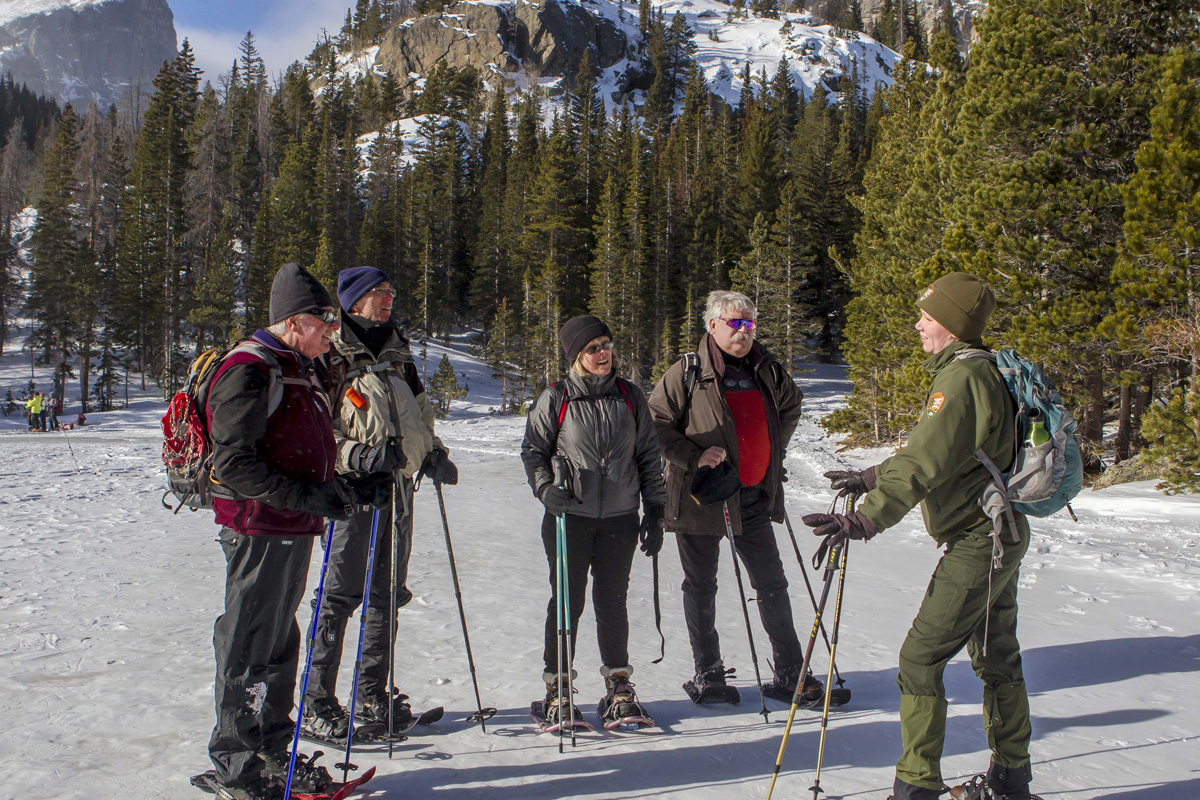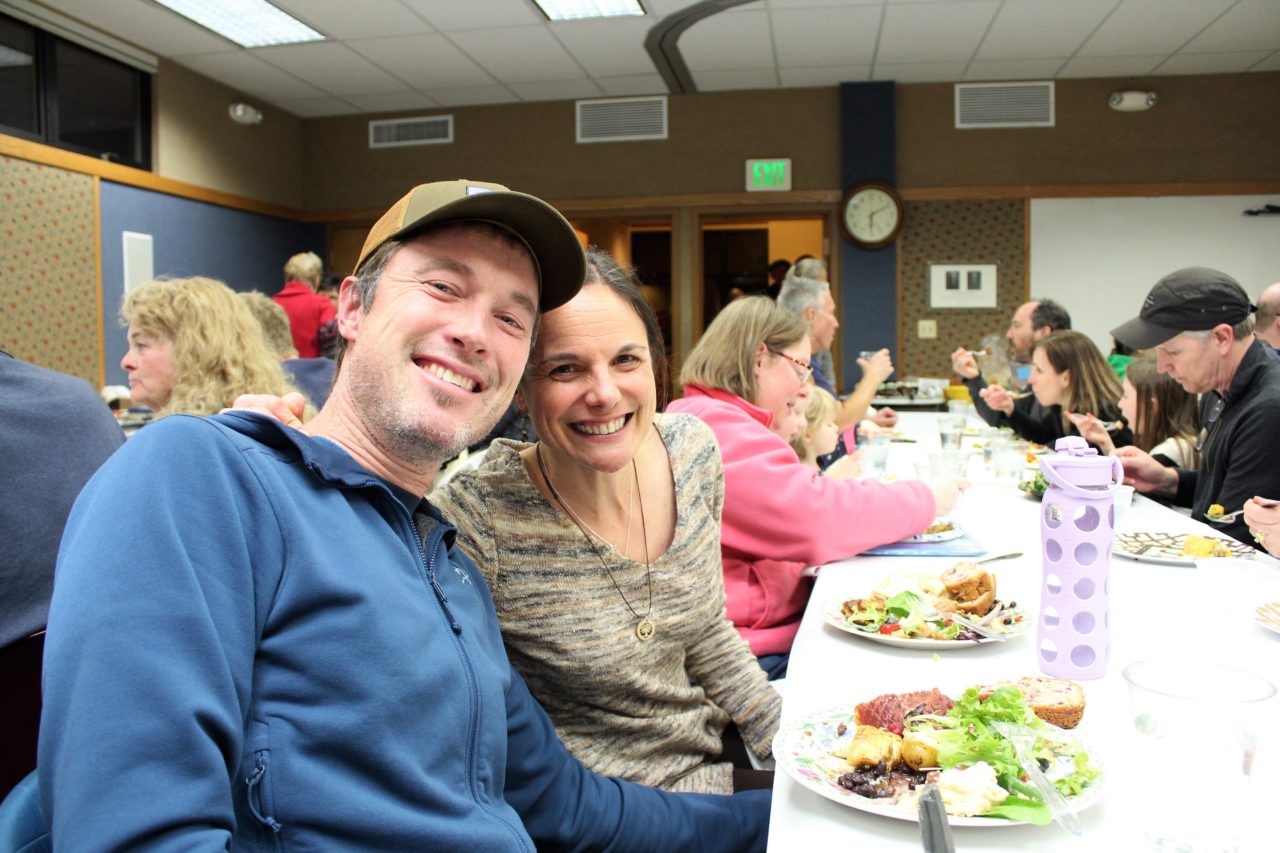Three days before Christmas, the government shutdown
began – and the people of Estes Park came together to save themselves.
by Dan England
On a blustery day in Estes Park, frosty even for January 24, the meals starting coming in the afternoon.
Workers in the Estes Valley Library, the only one in town, had to pause their regular hustle and bustle to get ready for that night’s event, the first of its kind. They received the dishes, offered thanks, and expressed the hope that the donor would come back that night to attend the potluck.
People brought salads, sure, but many brought heartier stuff – chilis, casseroles, meatloafs, side dishes that required gravy, breads and cupcakes and other comfort food. The town, and the people attending that night, needed the comfort. They’d needed it for a while, and winter’s brutal hand had nothing to do with it.
The federal government was more than a month into a shutdown, the longest in history, and Estes Park was feeling it. Its signature attraction, Rocky Mountain National Park, was nominally open for business, despite the government closure. But even the local curmudgeons – the ones who lived out in the woods and preferred winter’s relative peace and quiet over summer’s traffic jams – acknowledged the tourist town seemed eerily quiet. For downtown business owners, the hush was deafening.
The town’s prosperity has long depended on Rocky Mountain National Park. The park has been drawing spendy tourists to town for more than a century. It celebrated its centennial in 2015. But it has reached a new peak of popularity in recent years. RMNP drew close to 4.6 million visitors in 2018, the third-most among all national parks in the country. Not even Yosemite or Yellowstone drew as many.

Guided snowshoe tours are among the many attractions that draw winter tourists to RMNP. | Photo courtesy National Park Service
It’s so popular that even in winter, more than 100,000 people a month visit RMNP. Those visitors usually eat dinner in Estes Park, buy a T-shirt, fill up the gas tank, or at least sip a cup of hot coffee in a downtown cafe. Now, because of the shutdown, those people were staying away.
What was worse – much worse, in fact – were the nearly 150 permanent park employees who weren’t collecting a paycheck, along with various contractors and temporary employees. A lot of people around town were essentially unemployed during the shutdown.
Businesses had responded with free lunches and other gestures to federal employees. So had residents, leaving money at local stores to buy cups of coffee for furloughed workers. But as the town’s streets grew quieter every week, there were whispers of what people would have to do if the shutdown continued.
“Certainly there was a lot of concern about mid-January,” says Diana Laughlin, program services supervisor for the Estes Valley Library. “People were having meetings about the worst-case scenario. People were very nervous about their livelihoods.”
So the library scheduled the January 24 celebration for the park’s employees and more than 2,000 volunteers who help make RMNP run. Throughout the afternoon, hundreds of residents came by to drop off dishes – even people who couldn’t attend that evening’s event. There was so much food that library staff eventually had to buy every plastic container on the shelves at the local Safeway to pack up leftovers and send them home with the federal workers.
“We cannot emphasize enough what a simple expression of, ‘We are thinking of you,’ meant to park staff during the shutdown,” says Kyle Patterson, park public affairs director.
More than 150 people, half of them federal employees, came to the library that evening for food, games and performances. It was a fun, relaxing night in a town that had enjoyed few – since three days before Christmas, when the shutdown started.

“We were fortunate that the majority of visitors to Rocky were remarkable stewards during the shutdown.”
In September 2013, a slow-moving storm system dumped enough rain in the valley to turn the Big Thompson River into a frothing, ranging monster. The flood nearly put the town underwater before rushing down the canyon and destroying U.S. 34, one of the two main roads into Estes Park. Many neighboring towns and cities sustained damage as well, and a few were devastated, so it didn’t feel right to complain. But you could argue no town was hurt more than Estes Park. Residents could repair streets and buildings once the water receded, but they couldn’t replace the lost tourist dollars. Traffic had slowed to a trickle, because much of the highway down the canyon was reduced to bits of kibble. There were other ways to get to town, but many travelers either didn’t consider them or didn’t want to take the extra time to get there. Others just assumed the park was closed and the town was in ruins.
The flood brought more fear and uncertainty than the shutdown, Laughlin says, especially in the immediate aftermath. It was a more traumatic event. People wondered if they would have to leave for good. Even now, six years later, Laughlin says people feel nervous, even frightened, when a heavy rain hits – and the park’s high peaks can bring downpours almost daily in the summer.
“After the flood, the library was a clearinghouse for information and a place to gather,” Laughlin says. “And we definitely see ourselves in that role for anything that happens.” So once it became clear the shutdown was going to last longer than a few days, people naturally turned to the library for support.
“You saw more and more each week, people offering free meals, free nights or people taking credit for goods,” says Kurtis Kelly, the library’s communications coordinator. “All these things were developing. You saw that after the flood, too.”
Laughlin didn’t hear from many businesses that they were in danger of closing during the shutdown. And yet January was one of the slowest months ever in Estes Park. Amy Hamrick, owner of Kind Coffee in downtown Estes Park, witnessed it firsthand.
Hamrick moved to Estes Park in 1996 as an outdoor guide. She opened the Estes Park Coffee Co. two years later and became Kind Coffee in 2002. She’s loved how her shop, much like the library, is more than a business: It’s a gathering place, a social hub and an informal civic center for the community.
“As they come in, you’re having a conversation where you’re just sharing information with people,” Hamrick says. “People were angry or nervous or scared. We wouldn’t have had these conversations had the shutdown not been going on. Usually it’s something fun, like, ‘Where are you going in the park today?’”
Hamrick stayed open every day during the shutdown, both as a way to provide coffee to those who wanted to talk their fears away and as a symbol that they could all take the hit together. She didn’t cut employee hours either. The moves cost her money, and that was frustrating. It also reminded her of the flood, since she didn’t have much control over her losses.
They just happened.

The spirit of self-governance disappeared from D.C., but it remained strong in Estes Park. | Photo courtesy Estes Park Library
Nick Kenny loved the national park. It was the perfect place, only an hour away from his home in Greeley, to show off the state’s mountains whenever his Indiana relatives came to visit. He decided to volunteer after a friend told him about the opportunity, and he’s donated his time to the park since 2013, the year of the flood.
Even though the winter is his off-season – his speciality is helping to manage the fall crowds during elk-bugling season – the shutdown was a frustrating time for him and many other volunteers.
“We are there, and we are doing it for our love of the park,” Kenny said. “We’d be there in a drop of a pin if it meant to keep the park open. We’re volunteers for a reason. But when something like that happens, it seems like the things that suffer the most are the things that mean the most to our area.”
Alas, neither he nor anyone else was permitted to pitch in during the shutdown. Volunteers aren’t allowed in the park without staff supervision because of liability concerns.
The Rocky Mountain Conservancy, a nonprofit that’s supported the national park with fundraisers, visitor centers and volunteers since 1931, got many calls from people willing to help. The offer was tempting, but ultimately the organization turned them down, says Estee Murdock, the Conservancy’s executive director.
Murdock says the thinking was, “‘Let’s not add extra people into the park at this time,’ when we already had staff overwhelmed by the situation. It was a difficult time for everyone.”
Kenny and many others worried that, in the absence of regular employees, visitors would trash the park. But park law enforcement rangers established a strong presence early on, and staff (working without pay) sealed trash containers and closed vault toilet facilities during the second week of the shutdown. Three weeks in, money from user fees was approved to bring in some custodians, and plow drivers were hired to clear the roads for visitors. A few people did drive around some locked gates, and many others brought their dogs, a no-no in the national park. But most not only obeyed the laws but were even more careful to preserve the park than normal, even hauling their own trash out of the park, according to Patterson.
“We were fortunate that the majority of visitors to Rocky were remarkable stewards during the shutdown,” she says.
Visible impacts such as unclean restrooms or piled-up trash often generate headlines, but they can be fixed relatively easily. The hidden impacts of the shutdown were much worse, Patterson says. There were lapses in research sponsored by the Conservancy, and the organization’s high school internship program was badly disrupted. That program recruits promising out-of-town students to work in the park and participate in scientific activities, while building skills that could eventually benefit national parks as a whole or the Rocky Mountains specifically. With the park closed down, the Conservancy had to find other things for those students to do.
Families glumly came into the Conservancy’s visitor centers, trying to enjoy their vacations despite the lack of services. The Conservancy had to cancel an avalanche safety class in Hidden Valley because the roads weren’t plowed. The organization lost about $50,000 in sales at the visitor centers, and those dollars fund things that make your visit better, including that newspaper you get at the entrance that lists park events, attractions and locations.
Like so many others in Estes Park, the Conservancy was touched by acts of kindness from their neighbors. Even though it was a tough time for Kind Coffee and other local businesses, one day Hamrick reached out to Murdock and asked how much it cost to keep the visitor centers open. Murdock answered her, then went back to work.
A few minutes later, Hamrick returned with a donation.
“We feel it now,” Hamrick told her. “But it’s a tough time for all of us.”

Yet there’s always the chance that another shutdown could come. Trump still wants his wall, and the Democrats still refuse to fund it. There are plenty of other issues that could lead to another impasse and another shutdown.
Many politicians say that won’t happen, and the public beating that both parties took suggests that prediction is likely to come true. But that doesn’t set anyone in Estes Park at ease.
“That’s up to our Congress,” Murdock said. “At this point, it’s always a possibility it could happen again.”
The problem, of course, is that if another shutdown does happen this year, it would potentially be much more devastating. Especially if it happened at the height of the summer tourist season. “It would hurt a lot more,” Hamrick says. “A LOT more.”
So does she worry?
“You might as well be worried about another flash flood,” she says. “I have a full opinion of that, but you know, we can leave that out of the story.”
If another shutdown does occur, RMNP officials will again be able to use money from user fees for basic visitor services such as trash removal, plowing roads and maintaining restrooms. Kenny said, no matter what happens, his desire to volunteer hasn’t diminished. He loves the activity, and he loves the park. “I’ll be there always, regardless of what our government is doing,” he says.
Library officials aren’t thinking about it either. But when the next crisis hits – whatever and whenever it is – they’ll be there. “We want to keep responding to the needs in our community,” Laughlin says. “We hope people feel safe and welcome here.”
The library doesn’t plan to hold another potluck anytime soon, but maybe it should. Its homemade feast for federal employees on a cold night in January generated so much good karma that it seemed to spread all the way to Washington. The next morning, news broke that the 35-day shutdown was over.






